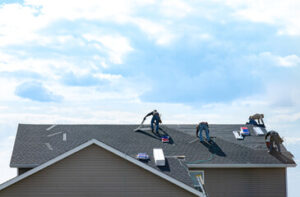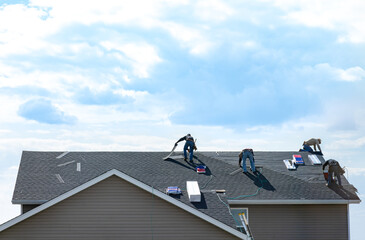The roof is the most vulnerable part of your home. It takes the most assaults from wind, rain, hail, bitter cold and sun.

Choosing the right roofing materials and installing them correctly can save you money over time. Before you start the project, learn the basics of roofing installation. Visit Website to learn more.
A roofer needs a variety of materials to do his or her job well. Many of these items can be purchased at a hardware store or even a big box store, though some may require a roofing contractor to obtain them in bulk and a truck to transport them. Having all the necessary equipment before starting a roofing job can prevent wasted time and trips back to the hardware store.
Some of the basic tools every roofer should have include a pry bar, a chalk reel, and a metal measuring tape. Using these tools will allow the roofer to snap chalk lines, which are used to mark the length of a new roof section or the placement of shingles along an open valley. The chalk line helps the roofer get accurate cuts when cutting shingle material and is also important for identifying where to place the first course of shingles, known as the starter course.
When laying down a new roof, the roofer will need shingles in various styles and colors, which can be obtained from the local roofing supply company. The roofing contractor will choose shingles that are rated for the climate where the house is located. A high-quality shingle is less likely to be damaged by hail and can last for 20 to 30 years.
The next item a roofer will need is a caulking gun, which allows the roofing contractor to dispense roofing cement easily and quickly. A good quality caulking gun will have a long life and is easy to clean. For roofing jobs that involve a lot of shingle installation, a caulking gun will save valuable time and make the process much more efficient.
Roofing contractors will often use insulation to protect the structure of the home and lower energy bills. Adding insulation will keep the house cooler in summer and warmer in winter, making it more comfortable for homeowners. A good insulation will also help the structure of the home resist water damage and other weather damage.
A roofer will need a pair of protective workwear, including gloves and eyewear. These will protect the worker against wood splinters, nails, and shingle pieces when tearing off old roofing materials. A hard hat is also a necessity to protect the head from falling debris during the job.
Inspection
The inspection process is a crucial part of a roofing project. It ensures that the finished product will protect your home from rain and other elements, and that it’s properly constructed. Inspectors look for any structural damage that could be caused by the new roof, as well as any areas where a new roof could allow water or pests to enter the house. The inspection will also include a survey of the exterior of your home, checking for any cracks or missing siding.
Inspectors will also examine the condition of the attic space, ensuring that there are no signs of moisture or leaking in the walls, ceilings and attic floor. They’ll check soffits, fascia and vents to ensure that they’re correctly installed. Inspectors will also check shingles and tiles to make sure that they’re not damaged or defective.
There are a number of things that can go wrong with a roof, from major issues like leaks and mold to less obvious ones like poor attic ventilation. Getting these issues fixed before they escalate is crucial for keeping your home healthy and comfortable. Luckily, many of these problems can be easily identified and fixed by a professional roofer during the installation process.
During the inspection, your roofer will check to make sure that all of the materials used for the new roof are as specified by the manufacturer. This means ensuring that the shingles are glued or nailed correctly, and that the flashing is shaped correctly to the roof. It’s also important to inspect the underlying roof materials for any damage or defects that may have occurred during construction, such as sagging or rot.
A quality inspector will also inspect the overall structure of the roof, looking at things like the joists and lathing. They’ll confirm that the layout of these materials matches up with the approved structural plans, and that they’re all properly secured and installed with the correct hardware. They’ll also check that the sheathing material isn’t exposing any of the interior shear, and that it’s properly secured and covered with the required roof covering.
Preparation
Before beginning the roofing installation process, the roof deck should be inspected to ensure that it is in good condition. Any sections of the deck that are damaged or rotted should be repaired or replaced. If there are any areas that are particularly weakened, the roofer will need to install an underlayment to protect against water infiltration.
The underlayment will also help the shingles to adhere to the roof. The underlayment can be installed over the existing shingles or over the entire roof surface. Once the underlayment is in place, the roofer will nail it down in a pattern that is close to the edge of the roof and then spread out more towards the middle. This will provide the best possible protection from leaks.
During the roofing installation process, the pounding of hammers and firing of nail guns will cause vibrations to travel through the house. This can dislodge or damage items stored in attic spaces. It is a good idea to remove or secure these items and cover anything that could be impacted by the vibrations, such as wall-hung pictures, mirrors, or delicate mementos. It is also a good idea to take down or cover window treatments, as debris and dust can easily fall onto them.
If you have children or pets, it is a good idea to keep them away from the working area during the roof replacement. The noise and activity can make them anxious, and they may wander into the dangerous working zone. If possible, find a safe space for them to stay inside the home during this time.
Before the roofers arrive, clear the yard of kids’ toys, patio furniture, grills, or lawn ornaments. The roofing professionals will need to walk all around the house to access the roof from different sides, and you don’t want them tripping on these items. You should also consider moving any outdoor furniture to a storage shed or garage or covering it with tarps to prevent damage from falling shingles. You should also mark or protect any plants that are particularly fragile or costly, and place netting or tarps over any koi ponds or other water features.
Installation
The roof installation process is meticulous and requires a high level of expertise. Whether a new roof is being installed or an existing one replaced, the first step in reroofing is to inspect the roof deck for damage or rot. Then, any damaged sections of the deck should be repaired or replaced. Next, a waterproof underlayment is installed. Common underlayment materials include asphalt-saturated felt or synthetic membranes.
After the underlayment is in place, the roofing contractor will add a layer of shingles. These shingles can be in a variety of styles and colors to match the look of the home. The shingles will be overlapped and nailed to the underlayment in a pattern that includes close nails at the edges and wider ones further from the center.
Depending on the type of roof, there may be vents and other penetrations in the roof. These should be sealed with roofing cement to prevent water leaks. Roof ventilation is important for reducing energy costs and preventing moisture damage to the roof deck and insulation. Typical roof vents include gable vents, ridge vents, and soffit vents. Hip and ridge shingles finish the look of the roof and provide additional protection from weather elements.
